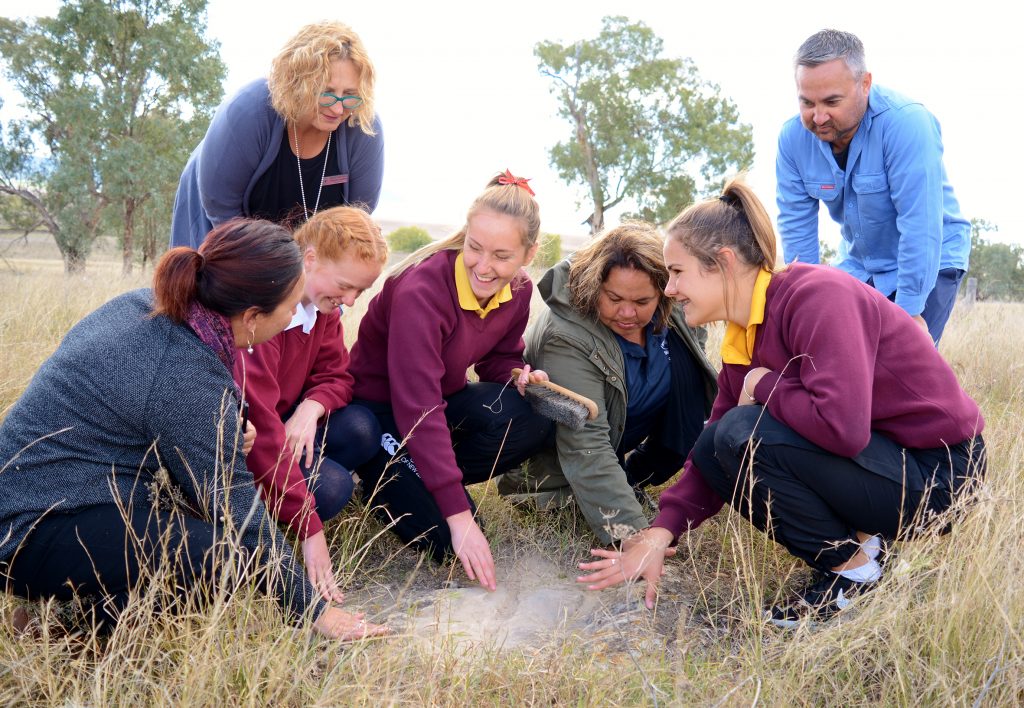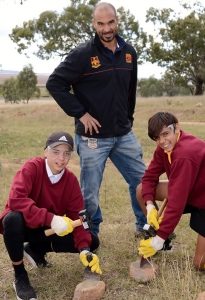Students went 'on country' with local Kamilaroi man Corie Taylor to learn how sandstone beds were used to shape and sharpen axe heads.

Students looking at a sandstone bed which was used for axe production
Students Georgie Auld, Lillie Clark and Tyra Nean learning about how sandstone beds were used in axe production with Deputy Principal Catherine Loughrey, Kamilaroi man Corie Taylor, Aboriginal Education Officer Megan Outerbridge and Student Support Leaving Officer Georgina Riley. Photo courtesy of Quirindi High School.
When school students think of science, they may think classrooms, labs and reports but a new pilot program at Quirindi High School is set to break these assumptions.
As part of the Inquiry for Indigenous Science Students (I2S2) program, year 9 students from Quirindi High School got to investigate ‘On Country’ how the Kamilaroi People used sophisticated geological knowledge to their advantage.
Pine Ridge in Quirindi (68km South West from Tamworth) was the perfect place for Yuundu (axe) production due to a combination of specific geological features.
Local Kamilaroi man, Corie Taylor, showed students and teachers how the sandstone beds provided a naturally abrasive material that was used to shape and sharpen axe heads.

Two students and a teacher learning about axe production
Students Brenndan Nea and Kobe Riley with Director of the Quirindi Clontarf Academy Mick Clark. Photo courtesy of Quirindi High School.
“Water was used as a lubricant during the shaping process, so the proximity of the sandstone to the Mooki River provided the perfect combination of factors required for this kind of tool production,” he said. “Several of the axes were made from granite that is suspected to have originated from a known granite axe quarry around 150kms from Pine Ridge. Large numbers of axe blanks were produced from this quarry before being further shaped in other locations such as Pine Ridge. The stone from this known quarry is renowned for its durable nature.”
“Another stone, Hornfel, begins as a sedimentary rock but through exposure to extreme temperatures hardens and becomes suitable for axe production. The ancient volcanic area around the Warrumbungles would have provided such opportunity for Hornfel to form and is also close enough to Pine Ridge to reasonably expect that the stone was ‘traded in’ to the area.”
After students were shown how the sandstone beds (or grinding stones) were used for tool production, they were given a hands-on opportunity to explore the properties of different rocks to determine which rock type would work best as an axe head. Hands-on learning with an Indigenous context is innovative and provides meaning by which Aboriginal and Torres Strait Islander Cultures, Histories and scientific knowledge can be at the centre of an authentic school curriculum.
New South Wales I2S2 coordinator Kate Shackleford said both the students and teachers learnt a lot from the practical aspects of the lesson. “A lot of the students said they didn’t realise this was considered science. They were all very positive about the experience.”
“This is the second year Quirindi High School has been involved in the I2S2 program and this year they are piloting on country excursions where they partner with their local Indigenous community to give local contextualised knowledge to engage students in science,” she said.
Inquiry for Indigenous Science Students (I2S2) is currently working with 77 schools across Australia and uses hands-on inquiry-based projects with an Indigenous context to increase student engagement and achievement in science. The program is part of the broader Indigenous STEM Project, delivered by CSIRO and funded by the BHP Billiton Foundation and aims to increase participation and achievement of Aboriginal and Torres Strait Islander students in science, technology, engineering and mathematics. You can find out more about the project here.


30th July 2017 at 9:37 pm
Great job on your first blog, Emma. Great to see the students learning about their culture.
22nd July 2017 at 12:59 am
If the premise is correct that it is possible to identify individual areas of the sandstone surface as having been used for axe production, then it should also be possible for an archaeological study at those locations to identify the debris from such grinding operations, the materials so ground against the sandstone and, from the quantities, and assumed layers of the debris, the total length of time that such manufacturing had been taking place at those locations. Food for thought?
31st July 2017 at 8:47 pm
Chris I wonder if the depth, width and number of grooves left on the many sandstone beds in the area, relative to weathering and other known impacts, would provide an easier means of determining how long this kind of activity persisted for, potentially eliminating the need for excavation? I’d be very interested to learn if a common stone type could be detected at any of the grinding sites in the area. The grooves at this particular location are shallow and narrow by comparison to others nearby that clearly demonstrate sustained use of an extended period of time.
21st July 2017 at 10:56 am
Thanks CSIRO for the opportunity to share this knowledge. It was a great day that allowed cultural knowledge to be shared and understood.